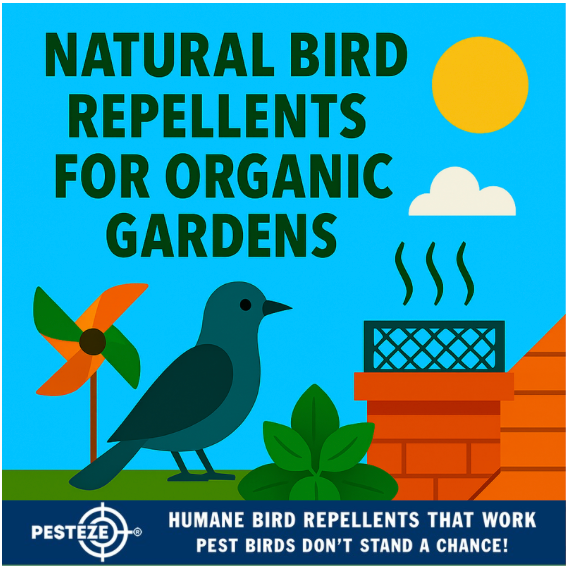NATURAL BIRD REPELLENTS FOR ORGANIC GARDENS

NATURAL BIRD REPELLENTS FOR ORGANIC GARDENS
SUMMARY
Organic gardeners need bird control methods that align with chemical-free growing principles while effectively protecting crops from damage. This specialized guide explores natural, non-toxic repellents and strategies that safeguard your organic harvest without compromising soil health or beneficial ecosystem relationships.
FEATURES
- Organic Certification Safe: Methods that maintain organic growing standards and certification requirements.
- Non-Toxic Solutions: Plant-based and natural repellents safe for children, pets, and beneficial wildlife.
- Ecosystem Friendly: Approaches that protect crops while supporting pollinators and beneficial insects.
- Homemade Recipes: DIY natural repellent formulations using common household and garden ingredients.
- Companion Planting: Strategic plant selections that naturally deter birds while enhancing garden health.
- Sustainable Methods: Long-term strategies that work within organic gardening principles and practices.
GUIDE DESCRIPTION
Organic gardens face unique challenges in bird control because traditional chemical deterrents violate organic principles and can harm beneficial insects, soil microorganisms, and water quality. Natural bird repellents offer effective protection while maintaining the ecological balance that organic gardening seeks to preserve.
Essential oil-based repellents provide powerful natural deterrence using concentrated plant compounds. Peppermint, cinnamon, and citrus oils create scent barriers that birds find unpleasant but won't harm plants or soil organisms. Mix 10-15 drops of essential oil with water and a small amount of dish soap for better adherence, then spray on vulnerable crops every few days or after rain.
Spice-based deterrents use common kitchen ingredients to create effective bird repellents. Cayenne pepper, chili powder, and garlic can be mixed with water to create spray solutions, or dusted directly on plants when dry weather is expected. These natural compounds irritate birds' senses without causing permanent harm while breaking down naturally in the environment.
Companion planting strategies incorporate plants that naturally repel birds while providing additional benefits to the garden ecosystem. Strong-scented herbs like rosemary, thyme, and marigolds planted around vulnerable crops can mask attractive food odors. Sunflowers and millet planted at garden perimeters serve as sacrificial crops, attracting birds away from main harvest areas.
Physical barriers using natural materials align with organic principles while providing reliable protection. Cheesecloth, burlap, and cotton mesh allow air and water circulation while preventing bird access to ripening fruit and vegetables. These biodegradable materials can be composted at the end of the season, unlike synthetic alternatives.
Predator attraction methods encourage natural bird control through ecological relationships. Installing owl boxes, hawk perches, and snake-friendly habitat areas near gardens can increase predator presence that naturally deters pest birds. This approach works within natural food webs rather than against them.
Homemade spray recipes combine multiple natural repellent ingredients for enhanced effectiveness. A popular organic formula includes crushed garlic, cayenne pepper, and biodegradable dish soap mixed with water. Allow the mixture to steep overnight before straining and applying to crops. Reapplication every 3-5 days maintains effectiveness, especially during peak ripening periods.
Timing applications correctly maximizes natural repellent effectiveness while minimizing impact on beneficial insects. Early morning applications allow repellents to dry before beneficial pollinators become active, while evening applications target the times when many pest birds are most active in gardens.
Crop rotation and timing strategies can reduce bird pressure by disrupting established feeding patterns. Planting susceptible crops in different locations each year prevents birds from anticipating food sources, while staggered planting times spread the harvest period and reduce concentrated attraction.
Water management plays a role in natural bird deterrence for organic gardens. Removing standing water sources and using drip irrigation instead of overhead sprinklers reduces the attractive combination of food and water that draws birds to garden areas. Rain collection systems can be positioned away from growing areas to redirect bird activity.
Beneficial bird encouragement balances pest control with ecological support by providing alternative food and nesting sites away from crop areas. Native flowering plants, natural water features, and appropriate nesting boxes positioned at garden peripheries can redirect bird activity while maintaining the biodiversity that organic gardens seek to support.
Seasonal adaptations align natural repellent strategies with organic garden cycles. Spring applications focus on protecting seedlings and early growth, summer strategies target fruit protection during ripening, and fall applications can protect late-season crops while preparing garden areas for winter wildlife support.
- Pukhraj Sharma


Comments 0